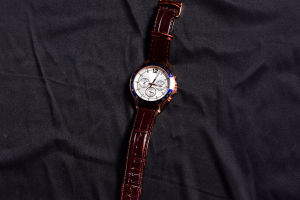As we look ahead to 2025, the watch industry is on the brink of an exciting transformation. No longer limited to just telling time, watches have become powerful symbols of both fashion and technology.
Over the past decade, we've witnessed an exciting convergence of high-end craftsmanship with cutting-edge tech, and this trend shows no sign of slowing down.
In this article, we'll dive into the major watch trends shaping the next few years, from the rise of smartwatches and hybrid models to the continued evolution of traditional mechanical timepieces. We'll also explore how technology and style are merging to create the watches of tomorrow.
Smartwatches: The Tech Revolution
The smartwatch trend is expected to continue dominating the market in 2025, but with a twist. While smartwatches were initially seen as purely functional devices, they're now becoming an essential part of personal style. What makes these timepieces stand out is not only their ability to sync with our smartphones but also the advancements in health tracking and customization.
• Health and Fitness Features: We are already seeing smartwatches offer features such as heart rate monitoring, ECG readings, sleep tracking, and even blood oxygen monitoring. By 2025, these features will only become more sophisticated, allowing us to monitor our overall well-being more efficiently.
• Design Evolution: Smartwatches are becoming sleeker, more stylish, and customizable. In 2025, expect to see a greater variety of designs, from luxurious models with diamond-encrusted faces to sporty options featuring advanced materials like titanium or ceramic. Major luxury brands, including Rolex and Tag Heuer, are already stepping into the smartwatch market, combining tech innovation with high-end watchmaking.
The fusion of function and fashion in smartwatches is paving the way for wearable tech that's not only useful but stylish enough to wear at any occasion.
Mechanical Watches: Timeless Craftsmanship
While technology continues to evolve, there's still a strong demand for traditional mechanical watches. In 2025, we expect to see the continued refinement of these masterpieces, with some exciting trends emerging within the world of horology.
• Sustainability and Ethical Sourcing: Consumers are increasingly looking for sustainable options, and luxury watchmakers are responding. The use of ethically sourced materials like conflict-free diamonds and recycled metals is expected to become more widespread. Additionally, the demand for watches that can be serviced and maintained for decades is pushing brands to focus on durability.
• Complicated Movements: High-end mechanical watches have always been valued for their complex movements, and in 2025, we'll see even more intricate designs, from perpetual calendars to moonphase displays. These watches continue to attract collectors and enthusiasts who value craftsmanship over digital tech.
• Customization: Personalization is a big part of the future of mechanical watches. Watchmakers are allowing customers to create bespoke pieces, from selecting materials to engraving unique messages. This trend will only grow, allowing individuals to express their personal style and taste.
Mechanical watches are far from obsolete—they remain a symbol of elegance and sophistication, and their craftsmanship continues to evolve.
Hybrid Watches: The Best of Both Worlds
One of the most exciting trends emerging by 2025 is the rise of hybrid watches—timepieces that combine the traditional mechanics of a classic watch with the modern tech of a smartwatch. These hybrid models offer the best of both worlds: a stylish, analog watch face paired with smart functionality.
• Smart Features with Classic Design: Hybrid watches will include features like step counting, sleep tracking, and notifications, all while maintaining a classic watch aesthetic. This makes them perfect for those who want to keep their style timeless without sacrificing modern functionality.
• Battery Life: One of the biggest advantages of hybrid watches is their battery life. Unlike traditional smartwatches, which need to be charged daily, hybrid watches can last for weeks on a single charge, making them incredibly practical.
In 2025, we expect hybrid watches to become even more refined, with greater customization options and an expanded range of features. These watches are ideal for those who want to stay connected while preserving the elegance of a traditional timepiece.
Materials and Innovation: Beyond the Basics
As the lines between technology and fashion continue to blur, we're also seeing some exciting material innovations in the watch industry. Expect to see watches that are lighter, stronger, and more eco-friendly in 2025.
• Advanced Materials: We're already seeing watches made from materials like ceramic, carbon fiber, and titanium, which are known for their strength and durability. In the future, expect even more innovative materials, such as graphene, which is incredibly lightweight and ultra-durable.
• Sustainability: The push for sustainability will continue to influence the watch industry. More and more brands are focusing on using recycled materials and eco-friendly production methods. Watches made from recycled ocean plastics, for instance, are likely to become a major trend.
• 3D Printing: 3D printing technology is already being used by some watchmakers to create intricate designs and prototype parts. By 2025, we expect to see more widespread use of 3D printing, enabling greater customization and more sustainable production practices.
Conclusion: The Future of Watches
As we approach 2025, the watch industry is undergoing a massive transformation. The fusion of technology and fashion has created a new wave of timepieces that combine the best of both worlds.
From smartwatches packed with health features to mechanical watches with intricate designs and hybrid models offering the best of both, the future of watches is incredibly exciting.
As we continue to move forward, it's clear that the future of timekeeping is not just about telling time—it's about making a statement, embracing innovation, and finding a watch that reflects our individual style. So, what are you waiting for? The watch of the future is here, and it's time to find the perfect one for you!


